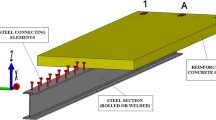Abstract
Steel–concrete hybrid systems are used in buildings, in which a steel structure has been placed on a concrete structure to make a lighter structure and have a faster construction. Dynamic analysis of hybrid structures is usually a complex procedure due to various dynamic characteristics of each part, i.e., stiffness, mass and especially damping. Dynamic response of hybrid structures has some complications. One of the reasons is the different stiffness of the two parts of structure and another reason is non-uniform distribution of materials and their different features such as damping in main modes of vibration. The available software is not able to calculate damping matrices and analyze these structures because the damping matrix of these irregular structures is non-classical. Also an equivalent damping should be devoted to the whole structure and using the available software. In the hybrid structures, one or more transitional storeys are used for better transition of lateral and gravity forces. In this study, an equation has been proposed to determine the equivalent uniform damping ratio for hybrid steel–concrete buildings with transitional storey(s). In the proposed method, the hybrid structure containing concrete, steel and transitional storeys appropriately substituted with 3-DOF structure. A wide range of eigenfrequency and mass ratios is examined for each ratio pair, and given the characteristics of the primary system, the complete 3-DOF structure can be formed. Equivalent uniform damping ratio is derived by means of a semi-empirical error minimization procedure. The multiple nonlinear regressions are used for determination of equations of modal damping ratios of hybrid buildings.








Similar content being viewed by others
References
Taranath BS (2011) Structural analysis and design of tall buildings: steel and composite construction. DeSimone Consulting Engineers, Nevada
Papageorgiou A, Gantes C. Decoupling criteria for dynamic response of primary/secondary structural systems. Proceedings of 4th European workshop on the seismic behavior of irregular and complex structures, 2005
Viest IM, Colaco JP, Furlong RW, Griffs LG, Leon RT, Wyllie LA (1997) Composite construction design for buildings. ASCE/McGraw-Hill, New York
Zhou H (2013) Damping of stay cable with passive-on magnetorheological dampers: a full-scale test. Int J Civil Eng 11:9–13
Hajjar JF (2002) Composite steel and concrete structural systems for seismic engineering. J Constr Steel Res 58:703–723
Li QS, Yang K, Zhang N, Wong CK, Jeary AP (2002) Field measurements of amplitude-dependent damping in a 79-storey tall building and its effects on the structural dynamic responses. J Struct Des Tall Spec Build 11:129–153
Johnson RP (2004) Composite structures of steel and concrete. Blackwell Scientific Publications, Oxford
Papageorgiou A, Gantes C (2011) Equivalent uniform damping ratios for linear irregularly damped concrete/steel mixed structures. Soil Dyn Earthq Eng 31:418–430
Zona A, Barbato M, Conte JP (2008) Nonlinear seismic response analysis of steel–concrete composite frames. J Struct Eng 14:986–997
Lee SH, Min KW, Hwang JS, Kim J (2004) Evaluation of equivalent damping ratio of a structure with added dampers. J Eng Struct 26:335–346
Villaverde R (2008) A complex modal superposition method for the seismic analysis of structures with supplemental dampers. Proceedings of the 14th World conference on earthquake engineering, 14WCEE, Beijing, China
Kim MC, Jung HJ, Lee IW (1999) Solution of eigenvalue problem for non-classically damped system with multiple frequencies. J Sound Vib 219:207–222
Xu J (2004) A synthesis formulation of explicit damping matrix for non-classically damped systems. Nucl Eng Des 227:125–132
Huang BC, Leung AYT, Lam KL, Cheung VK (1996) Analytical determination of equivalent modal damping ratios of a composite tower in wind-induced vibrations. J Comput Struct 59:311–316
Matlab, Interactive environment for algorithm development, data visualization, data analysis, and numeric computation, The Mathworks Inc., Natick, MA, USA. http://www.mathworks.com. Accessed 12 Jan 2014
IBM Corporation Released (2011) IBM SPSS statistics for windows. IBM Corporation, Amonk
Chopra AK (1995) Dynamics of structures: theory and application to earthquake engineering. Prentice-Hall, Upper-Saddle River
Clough RW, Penzien J (1993) Structural dynamics. McGraw Hill, New York
Adhikari S, Wagner N (2004) Direct time–domain integration method for exponentially damped linear systems. J Comput Struct 82:2453–2461
Cortes F, Mateos M, Elejabarrieta MJ (2009) A direct integration formulation for exponentially damped structural systems. J Comput Struct 87:391–394
Adhikari S (2000) Damping models for structural vibration. Ph.D. thesis. University of Cambridge
Chen G, Soong TT (1996) Exact solutions to a class of structure–equipment systems. J Eng Mech ASCE 122:1093–1100
Özgüven HN (2002) Twenty years of computational methods for harmonic response analysis of non-proportionally damped systems. Proceedings of the 20th international modal analysis conference, Los Angeles
Shahruz SM (1990) Approximate decoupling of the equations of motion of damped linear systems. J Sound Vib 136:51–64
Shahruz SM, Langari G (1992) Closeness of the solutions of approximately decoupled damped linear systems to their exact solutions. ASME J Dyn Syst Measur Control 114:369–374
Park IW, Kim JS, Ma F (1992) On modal coupling in non-classically damped linear systems. Mech Res Commun 19:407–413
Duncan PE, Taylor RE (1979) A note on the dynamic analysis of non-proportionally damped systems. J Earthq Eng Struct Dyn 7:99–105
Foss KA (1958) Co-ordinates which uncouple the equations of motion of damped linear dynamic systems. Trans ASME J Appl Mech 25:361–364
Author information
Authors and Affiliations
Corresponding author
Rights and permissions
About this article
Cite this article
Sivandi-Pour, A., Gerami, M. & Kheyroddin, A. Uniform Damping Ratio For Non-Classically Damped Hybrid Steel Concrete Structures. Int. J. Civ. Eng. 14, 1–11 (2016). https://doi.org/10.1007/s40999-016-0003-8
Received:
Revised:
Accepted:
Published:
Issue Date:
DOI: https://doi.org/10.1007/s40999-016-0003-8



